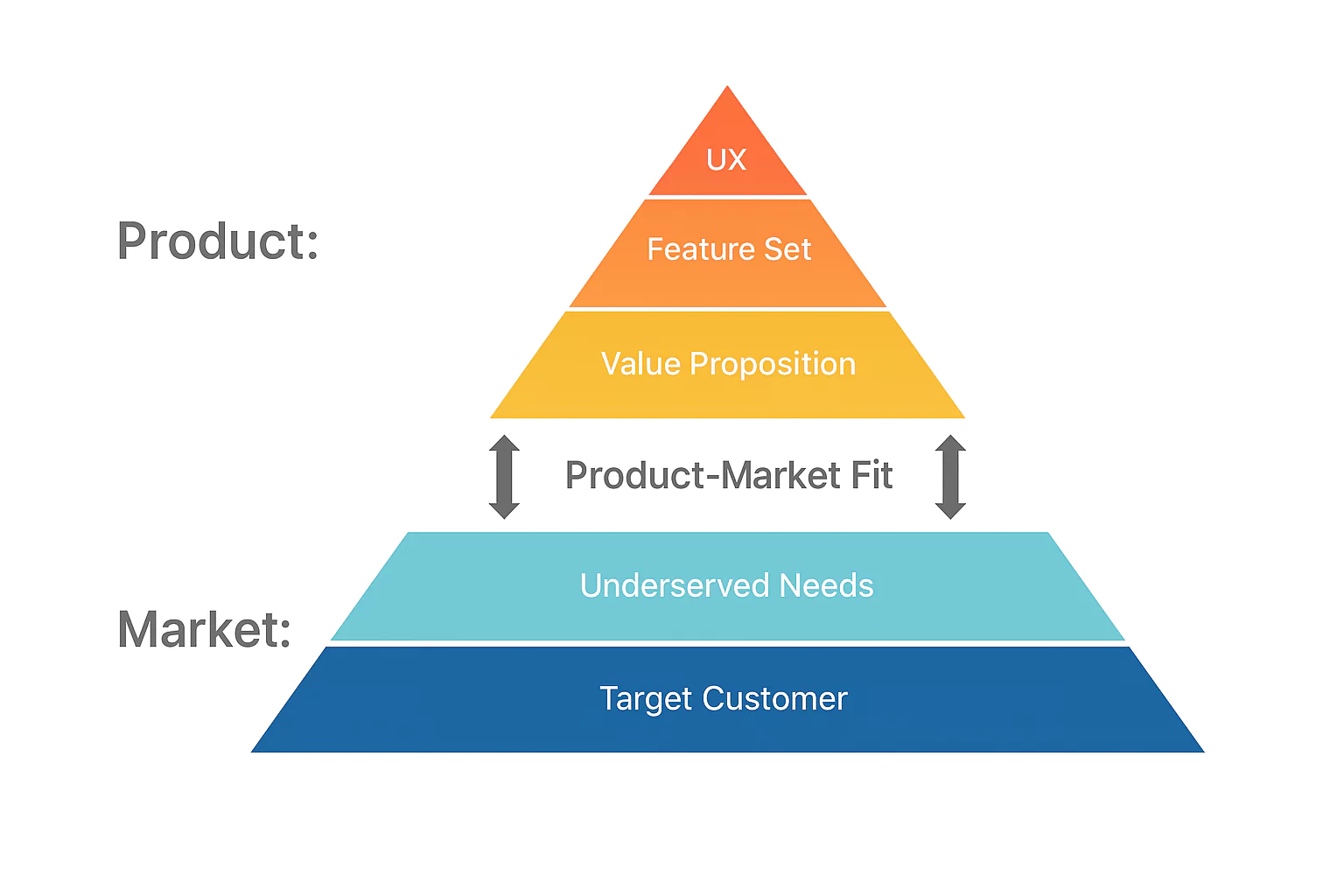Getting to the standard of product market fit is way too important for a business to be successful. If you want to be visible and preferred in the market then your product must pass certain quality and usability testing. If people are preferring your product and paying to buy it because they consider it better than the other options then your product is market fit.
Product market fit is an important factor you need to consider to make yourself successful in your field. Let us know how to figure out the product market fit and ways to achieve it easily.
Product Market Fit Definition & Overview
Product market fit is a criteria which conveys how well your product satisfies the needs of a specific group of people in the market. If your product solves one at least one significant problem of customers then it can be considered in the race of being fit.

Product market fit drives the success and growth of a business which can be analysed when a specific group of markets pays to buy your product and generate significant sales. With good product market fit you can get more revenues, profits, growth, collaboration, fundraising and more.
Due to a lot of competition it is not possible to determine the success probability of your product and there is no direct proven formula to ensure product market fit, the only ensured way is maintaining the top quality of the products or services you provide to your clients.
Read More: What is a certified Product Manager? Explain
Why Product Market Fit Is Important?
Product market fit is an essential outcome of your product when launched in the market as it measures whether or not your product is fit for organisation success. Let us get a complete overview of the importance of PMF in the market.
1. Proves that your Product Solves Real World Problems

Product market fit is a criteria which assess the quality and performance of your product in the market and it confirms that your product is actually genuine and the product you are delivering has some worth in the market.
A positive product market fit is a good sign for an organisation whether they are experimenting with a new product or just seeking approval for their regular product.
2. Drives Organic Growth in Market

When your product fits in the market then users will recommend your product to the next person which will drive a flow of organic growth for your organisation. This leads to word to mouth marketing which is more sustainable as compared to paid marketing and aggressive promotions of the product.
Read More: What is Growth Marketing?
3. Improves Customer Retention

You will get more retention in the market from people who find value in your product and are more likely to stick around for a longer time. PMF results in higher customer satisfaction with increased retention rates clearly visible in your metrics. Retaining customers is an important part of a business success.
4. Attracts Investors & Partners

A good Product fit attracts potential investors and partners toward the company and supports its growth as they see a good future by investing in this organisation with people trust and good services.
5. Saves Time & Wastage

When you evaluate your product fit in the market at an early stage then you might well save your money, time and energy from wasting on a product which is not recognised by users and they might not be ready to pay in future. But before discontinuing make sure you give enough time and cover all metrics of inspection.
Who Measures Product Market Fit?
Product market fit is a concept related to product management and a little bit of marketing. There is no specific department which is responsible for measuring the Product fit. It is a combined approach from all teams from various divisions such as sales, supports, finance, business development, and more.
The data collected from all these teams are used to understand the product fit in the market. Founders, product managers, growth teams and sometimes advisors having experience can participate in measuring the value. Product managers rely on data driven methods such as churn, retention rate, future usage, feedback and more to understand the product fit in the market.
What is the Sean Ellis Test?
The Sean Ellis Test is a product marketing strategy used especially by startups and product teams to measure the product market fit with critical points that testify whether or not your product satisfies the market demand.
There are certains questions asked to the concerned group of people such as “How would you feel if you could no longer use this product?” coming with options such as very disappointed, somewhat disappointed and not disappointed. Now, if 40% or more of the users say that they are very disappointed then it is a strong indicator of the product fit in the market.
However, a percentage less than 40% suggest that the product might still need some improvement or iteration to improve user experience, satisfy usability, and build strong retention.
How is Product Market Fit Measured?

Product fit is measured by considering various metrics but it is unique for different companies totally depending upon their target groups and domain. Let us get to the right approach of measuring product market fit below.
1. The Sean Ellis Test
This test can easily tell whether or not the product distributed in the market is up to the market. This method helps you decide whether or not you need improvement in your product followed by a series of iteration.
A series of questions are asked to users using surveys, forums, and more to understand their satisfaction with the product.
2. Customer Retention
Customer retention is a strong indicator of the product fit in the market. Always monitor how many users stick to the organisation and products for a longer time. A high retention rate means users find your product useful in their workflow.
Churn rates signal whether your product is lacking the product market fit using tools like retention curves, cohort analysis and more.
Read More: Why is Customer Relationship Management Important?
3. Net Promoter Score (NPS)
NPS is used to measure the customer satisfaction and loyalty with the product. It generally asks questions like how likely you are going to recommend this product on a scale of 0-10. If you get more of 9-10 points then you can consider a positive response on your product and a good product market fit.
4. User Engagement Metrics
If users interact more frequently with your product or platform such as logging in frequently, key actions, and explore features deeply which is a sign of strong engagement.
Some of the common metrics in user engagement metrics are session duration, feature usage frequency, daily active users, and more.
5. Conversion Metrics
Keep an eye on how many people are getting aware of your products and how many are actually buying. When customers are willing to pay, upgrade or subscribe to your products then you are meeting the real time market need.
When your Customer Acquisition Cost (CAC) is lower than the Lifetime Value (LV) then your product is a perfect fit for the market.
How to Achieve Product Fit for Market?

There is no guaranteed or full proof method to achieve market fit for each and every product of a company. But there are certain points we can keep in mind while serving in the market.
- Know your target customers: Be very familiar with your target audience and do not implement random ads and advertisements. Focus on your target group more and satisfy their needs with your products.
- Understand the Need of Customers: Stay familiar with what actually your target group needs and how your product can help them achieve it.
- Never Compromise on Quality: The quality of your product is one of the key metrics in making your product best marketing fit and hence it is important to never compromise on quality.
- Build a Minimum Viable Product (MVP): You can start small and build a simple version of your product at the starting and avoid adding fancy features. Your focus must only be on proving that your product can provide a solution and create value.
Also Read:
- What Is a Certified Product Manager (and How Do I Become One)
- What Is a Product Backlog
- Product Planning: What to Do, with Whom, and When
- What is Product Portfolio Management?
Learn Product Management With PW Skills
Become a pioneer in Product management skills with the power of Generative AI in our Product Management Course. Get complete in-depth training based on agile methodologies and conduct market analysis, strategic planning, and more to design and maintain a high valued product in the market.
Build your PRD from the scratch and work on a capstone project to strengthen your portfolio. Prepare for your interview with guidance from dedicated mentors who will also help you in resume building with dedicated sessions. Get industry recognised certifications and discover a wide range of opportunities in Product management only at pwskills.com

